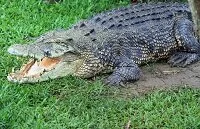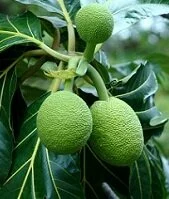Wildlife

Saltwater crocodile
As an island nation the number of native plants and animals in the Solomon Islands are severely limited, but the nearby island of New Guinea gives the Solomon Islands easy access to numerous plants and animals that have arrived over time in various methods. Despite the close proximity to other land masses, native land animals are almost completely absent and the native plant life is small; only the migrating birds and sea life had any significant presence on these islands in the past. However, thousands of plants and animals have arrived to the Solomon Islands from numerous places, including New Guinea, as people, winds, birds, and oceanic currents brought with them new seeds, plants, and animals.
Since most mammals are land animals there were no native mammals to the Solomon Islands, although a few bat species that could fly from island to island arrived early in the island's history. Other than this, no land mammals existed on the islands until the arrival of the earliest people, who came from the region of New Guinea and brought with them pigs, dogs, and rats by the 1200s if not earlier.
The other historic mammals present in the Solomon Islands came in the way of the sea life as dolphins and whales are present in the water surrounding the islands. These waters are also filled with thousands of fish, shellfish, and other forms of sea life. In these waters you can find surgeonfish, clownfish, puffer fish, butterfly fish, grouper, barracuda, tuna, mackerel, shrimp, krill, crab, seahorses, rays, sharks, jellyfish, starfish, and sea urchins among many others.

Breadfruit tree
Due to the overwhelming amount of water, it is not a surprise that most of the birds in the Solomon Islands are migratory birds or water fowls. The bird life includes rails, white-eyes, fantails, thrushes, honeyeaters, and parrots among others.
Like the mammalian life in the Solomon Islands, the reptilian and amphibious life is fairly limited. The most common of these animals are those adapted to the water and swimming as sea turtles and the saltwater crocodile can be found in the nearby waters. The islands are limited to a couple lizard species, frogs, and some snakes.
The insect and other small animal life is fairly diverse as many insects can fly or float and have made their way to the Solomon Islands. These animals include butterflies, bees, ants, flies, snails, and worms among others.
Like the native animal life, the native plant life is very limited. It is doubtful any plants originated in the Solomon Islands other than some local flowers and grasses. However the winds and water currents have taken seeds to the islands and in other cases birds and people have transported seeds to the islands. Because of this many of the most common plants native to the nearby islands of New Guinea and those further west have arrived to the Solomon Islands. These plants include coconuts, taro, breadfruit, bananas, yams, lemons, sugar, and perhaps even rice arrived in the islands during early human history.
There is also a substantial presence of other, non-edible, trees and plants, including orchids, ferns, mosses, mangrove trees, palm trees, and pandanus trees.